Strategic Information Systems Report: Westpac Bank and ERP Systems
VerifiedAdded on 2020/03/28
|16
|3777
|36
Report
AI Summary
This report examines the implementation of Accounting Information Systems and ERP systems within the Westpac Banking Group. It begins with an overview of Westpac's business processes, including primary and secondary functions, and outlines the bank's business requirements in the context of a dynamic technological environment. The report then delves into system requirements, emphasizing the need for reliable software and the adoption of technologies like big data and cloud computing. It recommends the ERP system, specifically SAP, as a suitable solution and discusses various ways technology can be utilized to gain business efficiency, such as through information and communication, online banking, and customer engagement. The study highlights the efficiency achieved from technology implementation, including reduced operational costs and improved customer relationships. Finally, it addresses potential risks associated with system implementation and suggests mitigation strategies, concluding with an overview of the benefits of integrating technology within the banking sector.
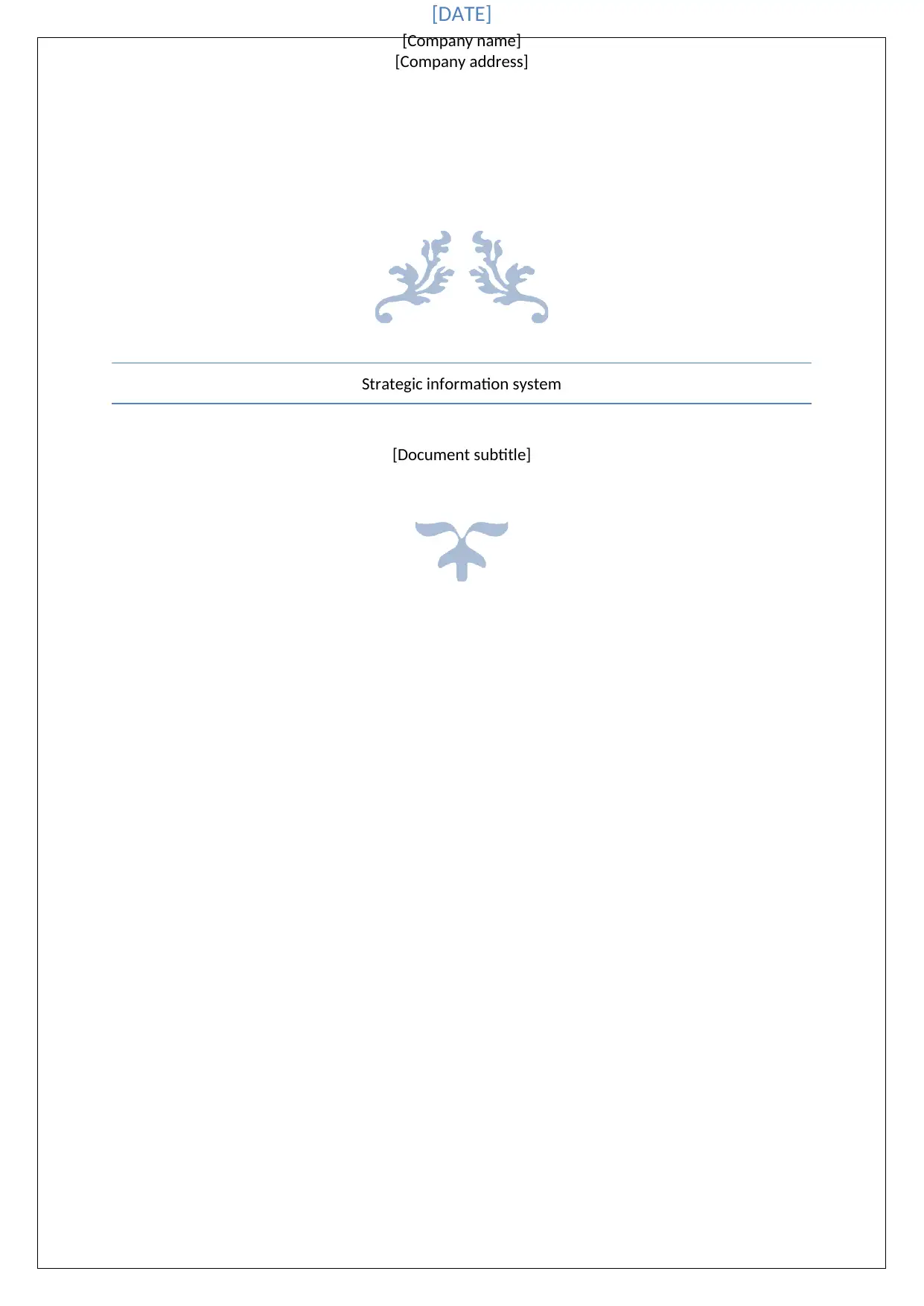
Strategic information system
[Document subtitle]
[DATE]
[Company name]
[Company address]
[Document subtitle]
[DATE]
[Company name]
[Company address]
Paraphrase This Document
Need a fresh take? Get an instant paraphrase of this document with our AI Paraphraser
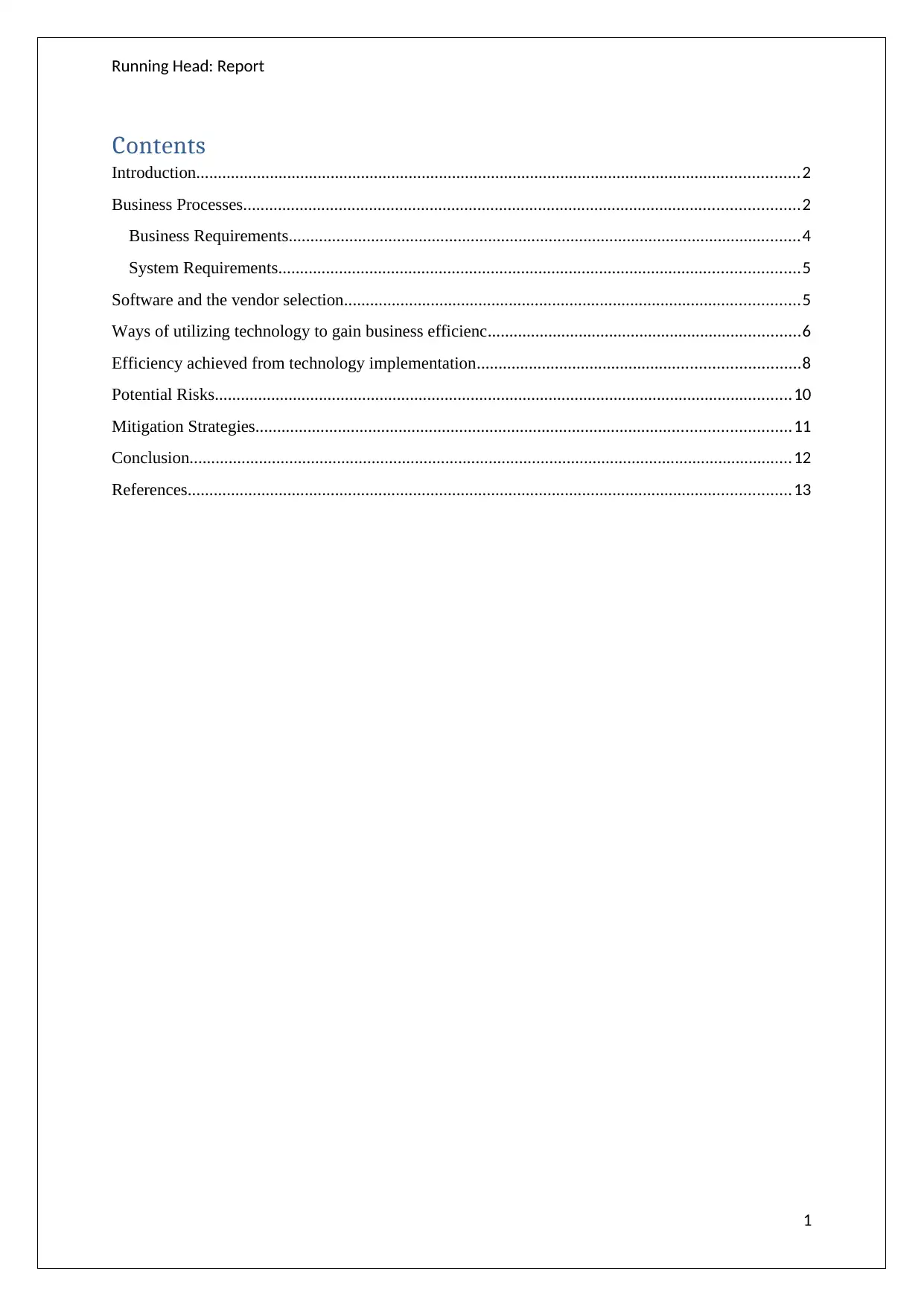
Running Head: Report
Contents
Introduction...........................................................................................................................................2
Business Processes................................................................................................................................2
Business Requirements......................................................................................................................4
System Requirements........................................................................................................................5
Software and the vendor selection.........................................................................................................5
Ways of utilizing technology to gain business efficienc........................................................................6
Efficiency achieved from technology implementation..........................................................................8
Potential Risks.....................................................................................................................................10
Mitigation Strategies...........................................................................................................................11
Conclusion...........................................................................................................................................12
References...........................................................................................................................................13
1
Contents
Introduction...........................................................................................................................................2
Business Processes................................................................................................................................2
Business Requirements......................................................................................................................4
System Requirements........................................................................................................................5
Software and the vendor selection.........................................................................................................5
Ways of utilizing technology to gain business efficienc........................................................................6
Efficiency achieved from technology implementation..........................................................................8
Potential Risks.....................................................................................................................................10
Mitigation Strategies...........................................................................................................................11
Conclusion...........................................................................................................................................12
References...........................................................................................................................................13
1
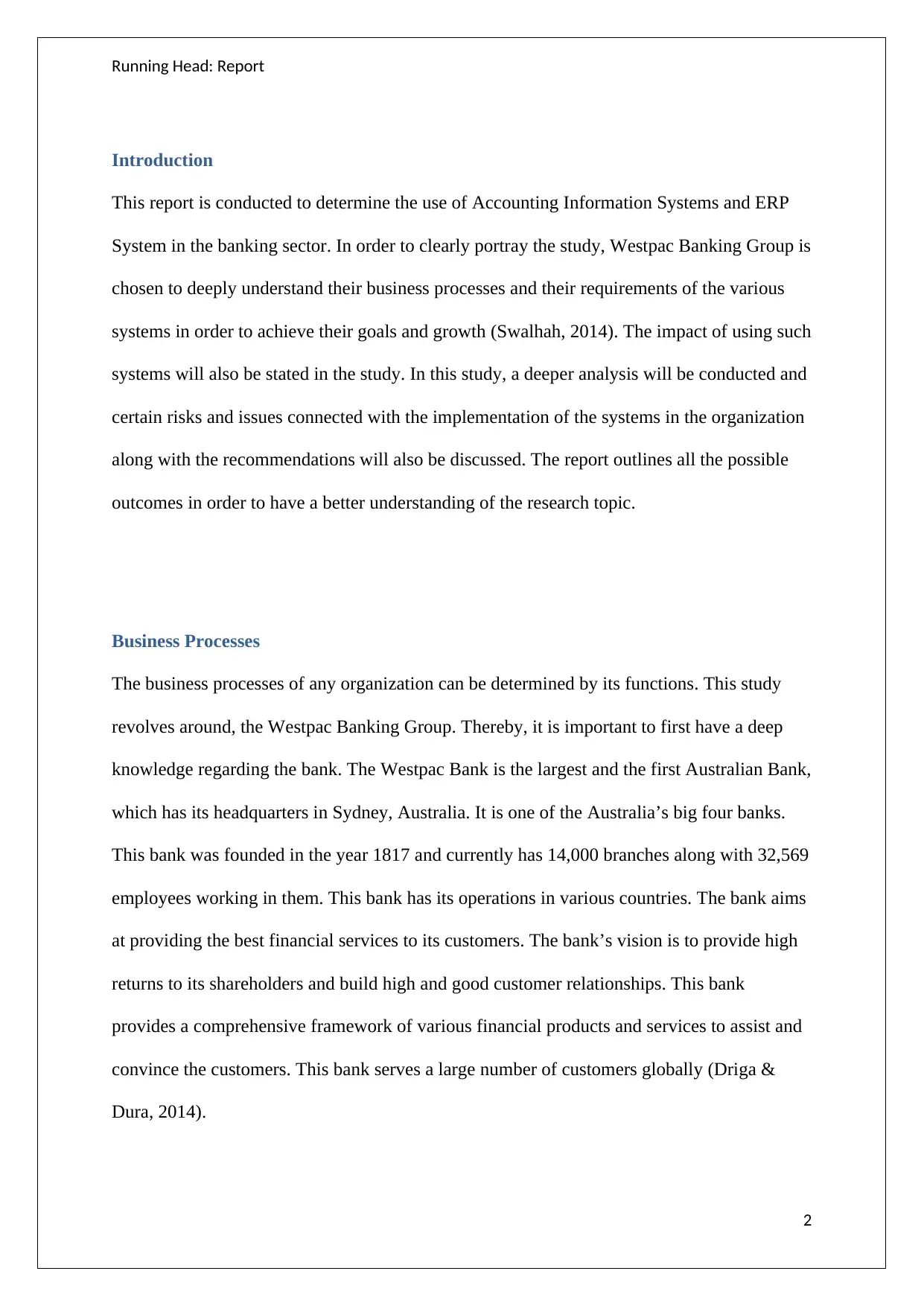
Running Head: Report
Introduction
This report is conducted to determine the use of Accounting Information Systems and ERP
System in the banking sector. In order to clearly portray the study, Westpac Banking Group is
chosen to deeply understand their business processes and their requirements of the various
systems in order to achieve their goals and growth (Swalhah, 2014). The impact of using such
systems will also be stated in the study. In this study, a deeper analysis will be conducted and
certain risks and issues connected with the implementation of the systems in the organization
along with the recommendations will also be discussed. The report outlines all the possible
outcomes in order to have a better understanding of the research topic.
Business Processes
The business processes of any organization can be determined by its functions. This study
revolves around, the Westpac Banking Group. Thereby, it is important to first have a deep
knowledge regarding the bank. The Westpac Bank is the largest and the first Australian Bank,
which has its headquarters in Sydney, Australia. It is one of the Australia’s big four banks.
This bank was founded in the year 1817 and currently has 14,000 branches along with 32,569
employees working in them. This bank has its operations in various countries. The bank aims
at providing the best financial services to its customers. The bank’s vision is to provide high
returns to its shareholders and build high and good customer relationships. This bank
provides a comprehensive framework of various financial products and services to assist and
convince the customers. This bank serves a large number of customers globally (Driga &
Dura, 2014).
2
Introduction
This report is conducted to determine the use of Accounting Information Systems and ERP
System in the banking sector. In order to clearly portray the study, Westpac Banking Group is
chosen to deeply understand their business processes and their requirements of the various
systems in order to achieve their goals and growth (Swalhah, 2014). The impact of using such
systems will also be stated in the study. In this study, a deeper analysis will be conducted and
certain risks and issues connected with the implementation of the systems in the organization
along with the recommendations will also be discussed. The report outlines all the possible
outcomes in order to have a better understanding of the research topic.
Business Processes
The business processes of any organization can be determined by its functions. This study
revolves around, the Westpac Banking Group. Thereby, it is important to first have a deep
knowledge regarding the bank. The Westpac Bank is the largest and the first Australian Bank,
which has its headquarters in Sydney, Australia. It is one of the Australia’s big four banks.
This bank was founded in the year 1817 and currently has 14,000 branches along with 32,569
employees working in them. This bank has its operations in various countries. The bank aims
at providing the best financial services to its customers. The bank’s vision is to provide high
returns to its shareholders and build high and good customer relationships. This bank
provides a comprehensive framework of various financial products and services to assist and
convince the customers. This bank serves a large number of customers globally (Driga &
Dura, 2014).
2
⊘ This is a preview!⊘
Do you want full access?
Subscribe today to unlock all pages.

Trusted by 1+ million students worldwide
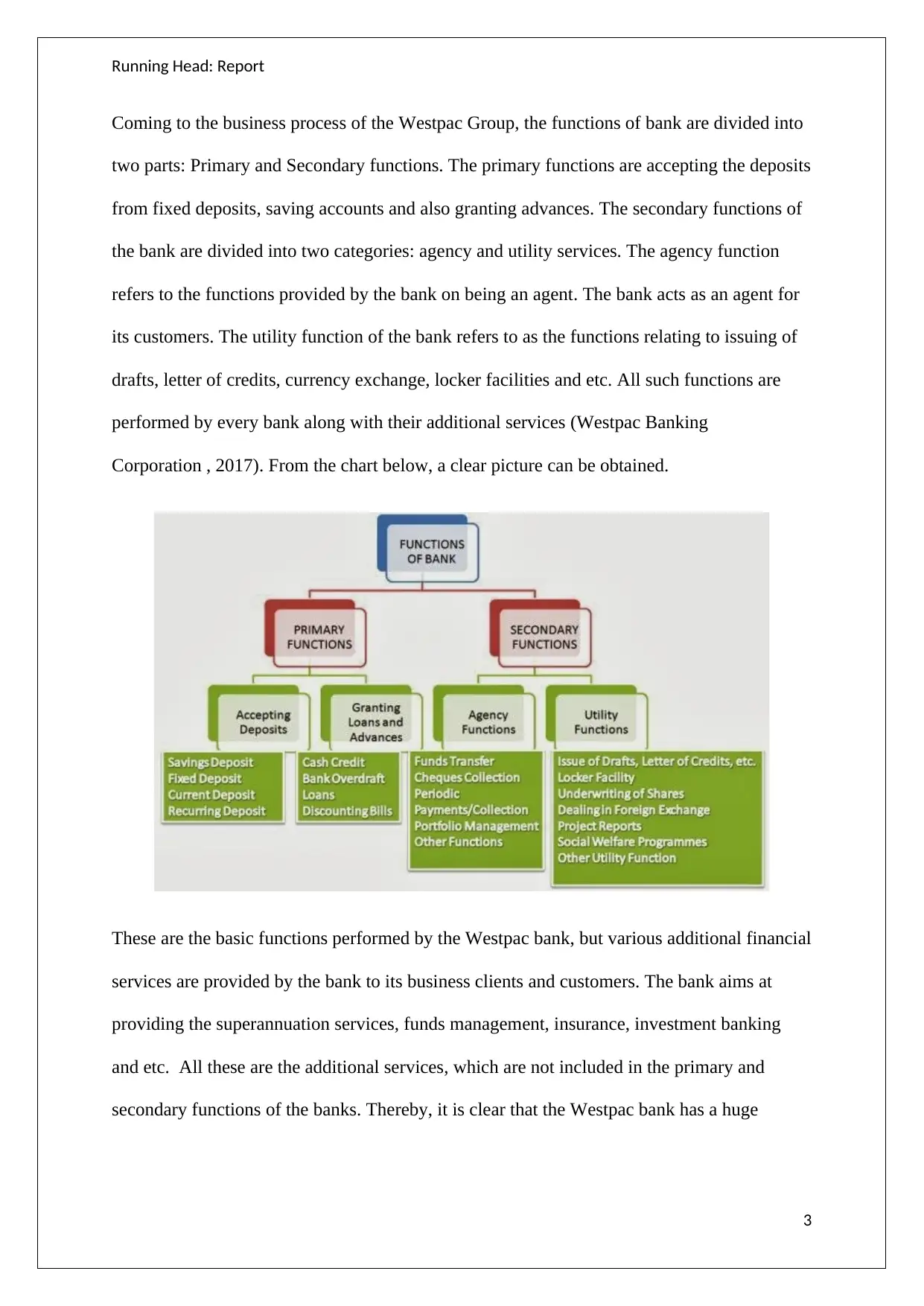
Running Head: Report
Coming to the business process of the Westpac Group, the functions of bank are divided into
two parts: Primary and Secondary functions. The primary functions are accepting the deposits
from fixed deposits, saving accounts and also granting advances. The secondary functions of
the bank are divided into two categories: agency and utility services. The agency function
refers to the functions provided by the bank on being an agent. The bank acts as an agent for
its customers. The utility function of the bank refers to as the functions relating to issuing of
drafts, letter of credits, currency exchange, locker facilities and etc. All such functions are
performed by every bank along with their additional services (Westpac Banking
Corporation , 2017). From the chart below, a clear picture can be obtained.
These are the basic functions performed by the Westpac bank, but various additional financial
services are provided by the bank to its business clients and customers. The bank aims at
providing the superannuation services, funds management, insurance, investment banking
and etc. All these are the additional services, which are not included in the primary and
secondary functions of the banks. Thereby, it is clear that the Westpac bank has a huge
3
Coming to the business process of the Westpac Group, the functions of bank are divided into
two parts: Primary and Secondary functions. The primary functions are accepting the deposits
from fixed deposits, saving accounts and also granting advances. The secondary functions of
the bank are divided into two categories: agency and utility services. The agency function
refers to the functions provided by the bank on being an agent. The bank acts as an agent for
its customers. The utility function of the bank refers to as the functions relating to issuing of
drafts, letter of credits, currency exchange, locker facilities and etc. All such functions are
performed by every bank along with their additional services (Westpac Banking
Corporation , 2017). From the chart below, a clear picture can be obtained.
These are the basic functions performed by the Westpac bank, but various additional financial
services are provided by the bank to its business clients and customers. The bank aims at
providing the superannuation services, funds management, insurance, investment banking
and etc. All these are the additional services, which are not included in the primary and
secondary functions of the banks. Thereby, it is clear that the Westpac bank has a huge
3
Paraphrase This Document
Need a fresh take? Get an instant paraphrase of this document with our AI Paraphraser
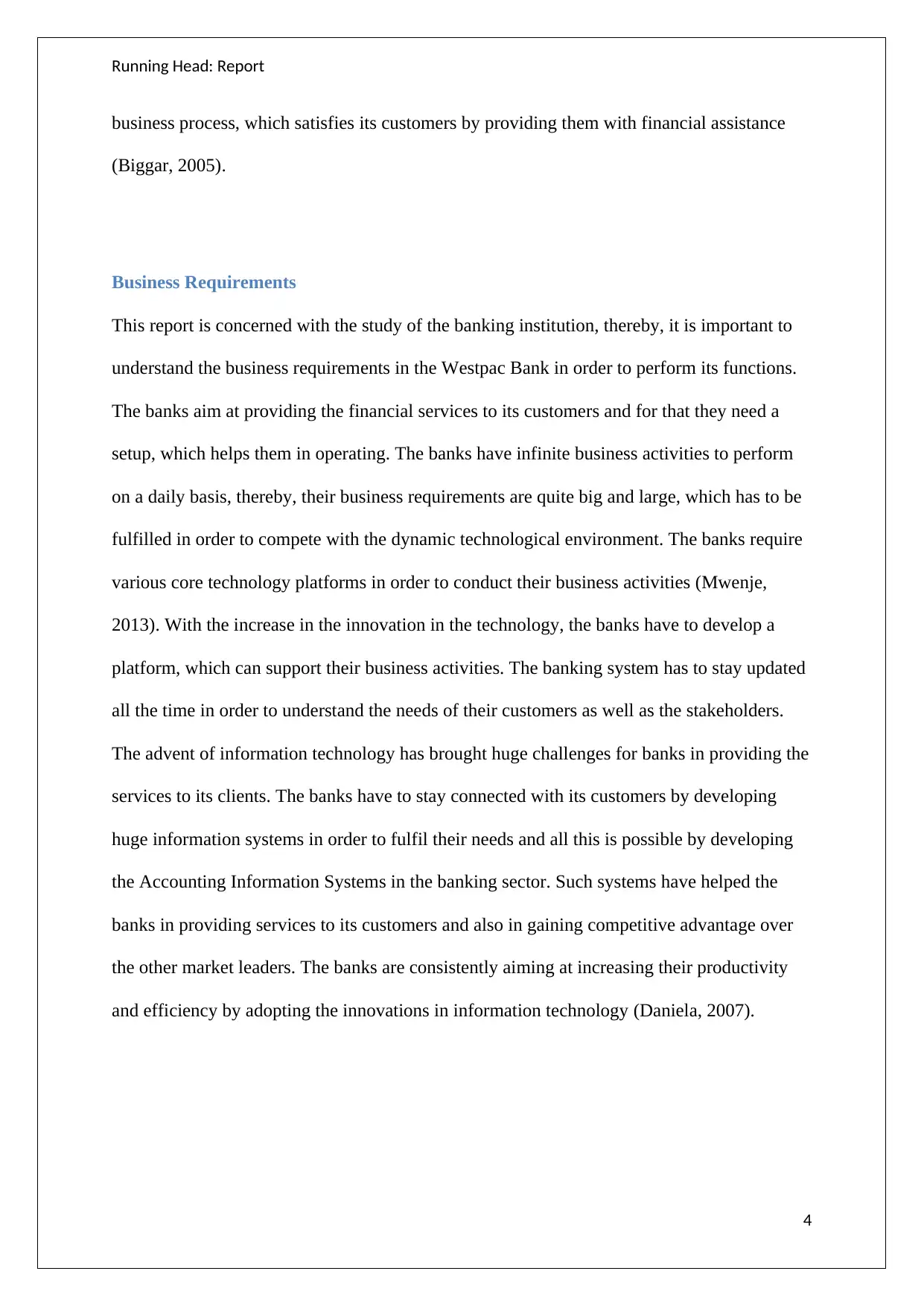
Running Head: Report
business process, which satisfies its customers by providing them with financial assistance
(Biggar, 2005).
Business Requirements
This report is concerned with the study of the banking institution, thereby, it is important to
understand the business requirements in the Westpac Bank in order to perform its functions.
The banks aim at providing the financial services to its customers and for that they need a
setup, which helps them in operating. The banks have infinite business activities to perform
on a daily basis, thereby, their business requirements are quite big and large, which has to be
fulfilled in order to compete with the dynamic technological environment. The banks require
various core technology platforms in order to conduct their business activities (Mwenje,
2013). With the increase in the innovation in the technology, the banks have to develop a
platform, which can support their business activities. The banking system has to stay updated
all the time in order to understand the needs of their customers as well as the stakeholders.
The advent of information technology has brought huge challenges for banks in providing the
services to its clients. The banks have to stay connected with its customers by developing
huge information systems in order to fulfil their needs and all this is possible by developing
the Accounting Information Systems in the banking sector. Such systems have helped the
banks in providing services to its customers and also in gaining competitive advantage over
the other market leaders. The banks are consistently aiming at increasing their productivity
and efficiency by adopting the innovations in information technology (Daniela, 2007).
4
business process, which satisfies its customers by providing them with financial assistance
(Biggar, 2005).
Business Requirements
This report is concerned with the study of the banking institution, thereby, it is important to
understand the business requirements in the Westpac Bank in order to perform its functions.
The banks aim at providing the financial services to its customers and for that they need a
setup, which helps them in operating. The banks have infinite business activities to perform
on a daily basis, thereby, their business requirements are quite big and large, which has to be
fulfilled in order to compete with the dynamic technological environment. The banks require
various core technology platforms in order to conduct their business activities (Mwenje,
2013). With the increase in the innovation in the technology, the banks have to develop a
platform, which can support their business activities. The banking system has to stay updated
all the time in order to understand the needs of their customers as well as the stakeholders.
The advent of information technology has brought huge challenges for banks in providing the
services to its clients. The banks have to stay connected with its customers by developing
huge information systems in order to fulfil their needs and all this is possible by developing
the Accounting Information Systems in the banking sector. Such systems have helped the
banks in providing services to its customers and also in gaining competitive advantage over
the other market leaders. The banks are consistently aiming at increasing their productivity
and efficiency by adopting the innovations in information technology (Daniela, 2007).
4
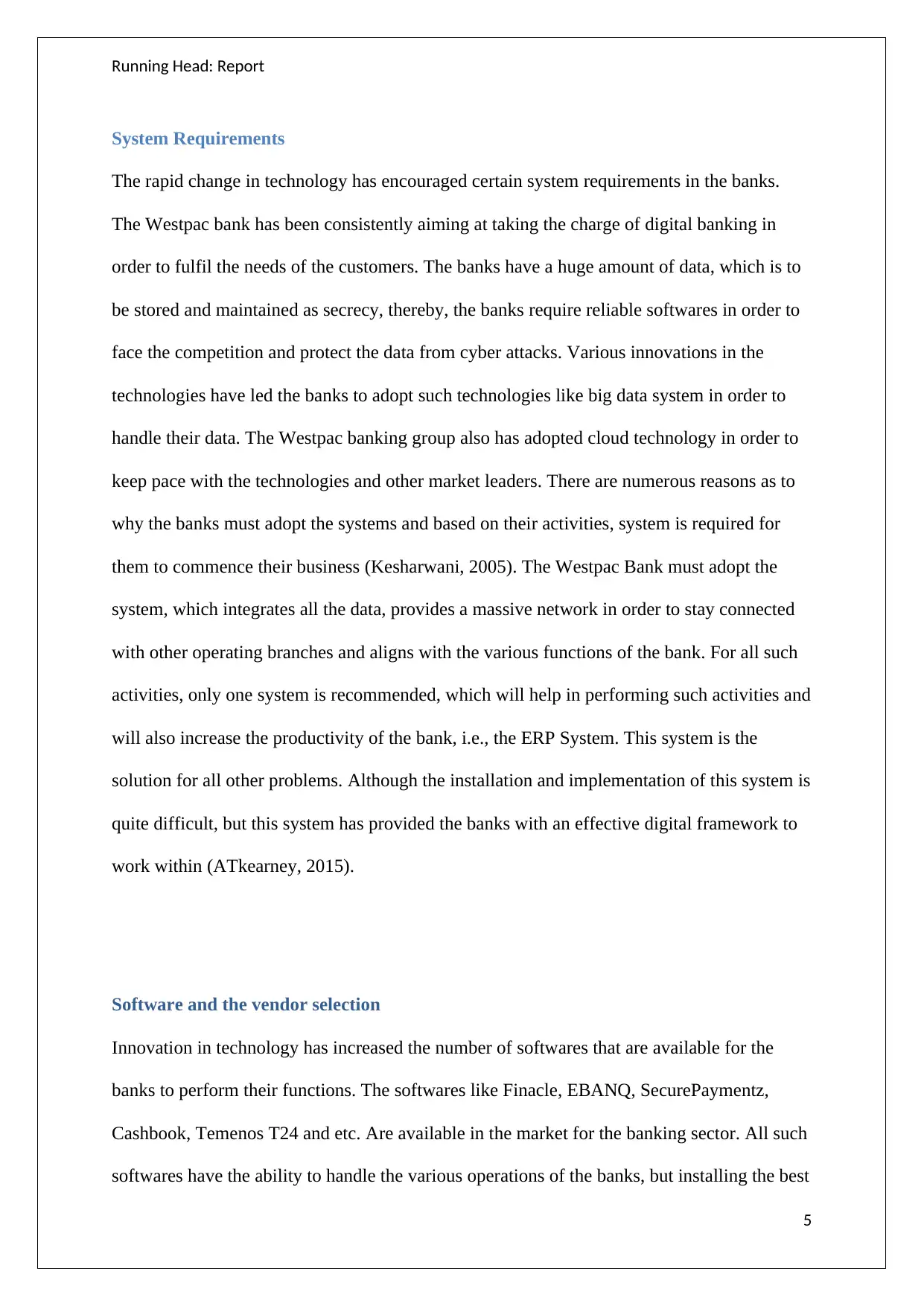
Running Head: Report
System Requirements
The rapid change in technology has encouraged certain system requirements in the banks.
The Westpac bank has been consistently aiming at taking the charge of digital banking in
order to fulfil the needs of the customers. The banks have a huge amount of data, which is to
be stored and maintained as secrecy, thereby, the banks require reliable softwares in order to
face the competition and protect the data from cyber attacks. Various innovations in the
technologies have led the banks to adopt such technologies like big data system in order to
handle their data. The Westpac banking group also has adopted cloud technology in order to
keep pace with the technologies and other market leaders. There are numerous reasons as to
why the banks must adopt the systems and based on their activities, system is required for
them to commence their business (Kesharwani, 2005). The Westpac Bank must adopt the
system, which integrates all the data, provides a massive network in order to stay connected
with other operating branches and aligns with the various functions of the bank. For all such
activities, only one system is recommended, which will help in performing such activities and
will also increase the productivity of the bank, i.e., the ERP System. This system is the
solution for all other problems. Although the installation and implementation of this system is
quite difficult, but this system has provided the banks with an effective digital framework to
work within (ATkearney, 2015).
Software and the vendor selection
Innovation in technology has increased the number of softwares that are available for the
banks to perform their functions. The softwares like Finacle, EBANQ, SecurePaymentz,
Cashbook, Temenos T24 and etc. Are available in the market for the banking sector. All such
softwares have the ability to handle the various operations of the banks, but installing the best
5
System Requirements
The rapid change in technology has encouraged certain system requirements in the banks.
The Westpac bank has been consistently aiming at taking the charge of digital banking in
order to fulfil the needs of the customers. The banks have a huge amount of data, which is to
be stored and maintained as secrecy, thereby, the banks require reliable softwares in order to
face the competition and protect the data from cyber attacks. Various innovations in the
technologies have led the banks to adopt such technologies like big data system in order to
handle their data. The Westpac banking group also has adopted cloud technology in order to
keep pace with the technologies and other market leaders. There are numerous reasons as to
why the banks must adopt the systems and based on their activities, system is required for
them to commence their business (Kesharwani, 2005). The Westpac Bank must adopt the
system, which integrates all the data, provides a massive network in order to stay connected
with other operating branches and aligns with the various functions of the bank. For all such
activities, only one system is recommended, which will help in performing such activities and
will also increase the productivity of the bank, i.e., the ERP System. This system is the
solution for all other problems. Although the installation and implementation of this system is
quite difficult, but this system has provided the banks with an effective digital framework to
work within (ATkearney, 2015).
Software and the vendor selection
Innovation in technology has increased the number of softwares that are available for the
banks to perform their functions. The softwares like Finacle, EBANQ, SecurePaymentz,
Cashbook, Temenos T24 and etc. Are available in the market for the banking sector. All such
softwares have the ability to handle the various operations of the banks, but installing the best
5
⊘ This is a preview!⊘
Do you want full access?
Subscribe today to unlock all pages.

Trusted by 1+ million students worldwide
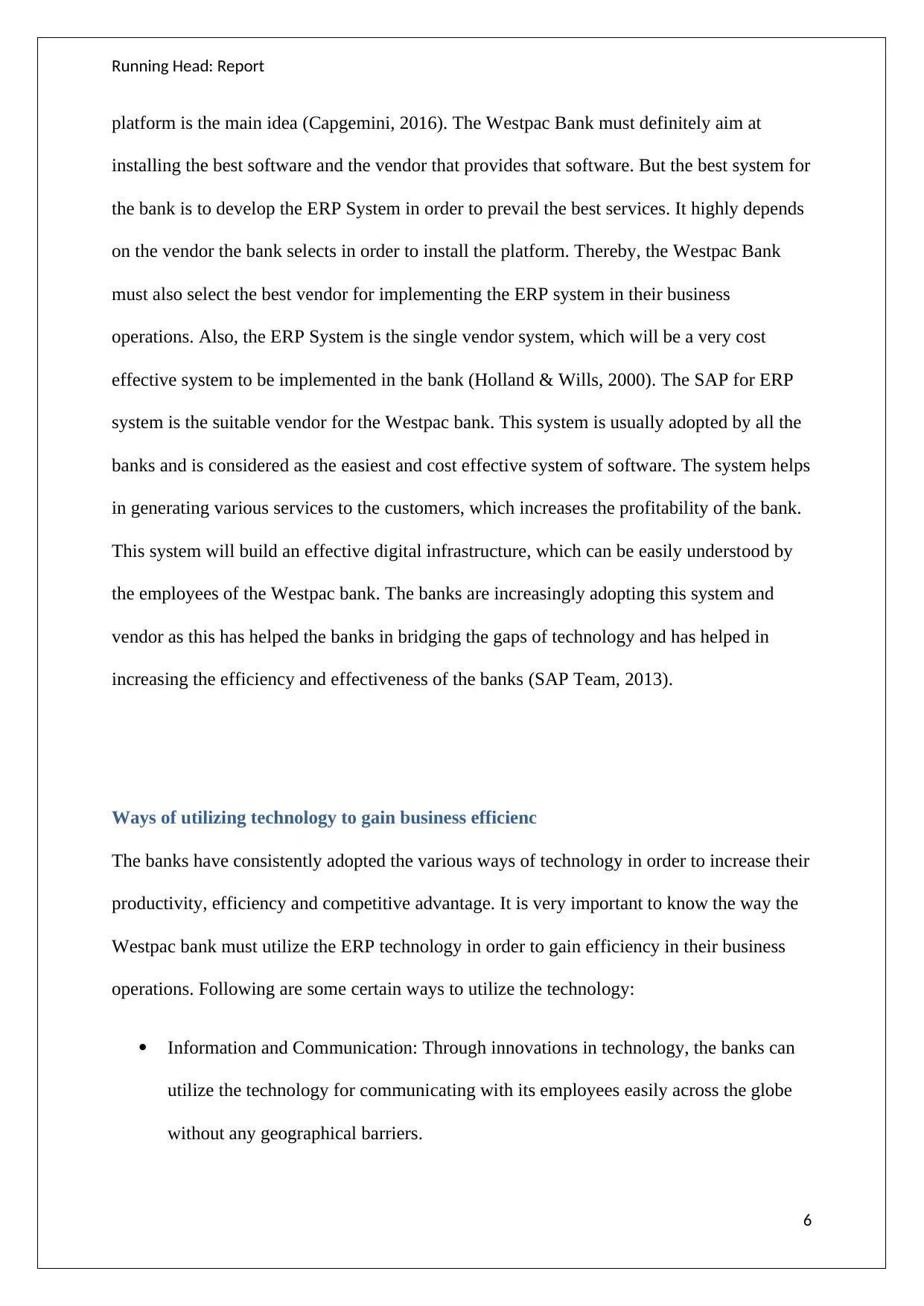
Running Head: Report
platform is the main idea (Capgemini, 2016). The Westpac Bank must definitely aim at
installing the best software and the vendor that provides that software. But the best system for
the bank is to develop the ERP System in order to prevail the best services. It highly depends
on the vendor the bank selects in order to install the platform. Thereby, the Westpac Bank
must also select the best vendor for implementing the ERP system in their business
operations. Also, the ERP System is the single vendor system, which will be a very cost
effective system to be implemented in the bank (Holland & Wills, 2000). The SAP for ERP
system is the suitable vendor for the Westpac bank. This system is usually adopted by all the
banks and is considered as the easiest and cost effective system of software. The system helps
in generating various services to the customers, which increases the profitability of the bank.
This system will build an effective digital infrastructure, which can be easily understood by
the employees of the Westpac bank. The banks are increasingly adopting this system and
vendor as this has helped the banks in bridging the gaps of technology and has helped in
increasing the efficiency and effectiveness of the banks (SAP Team, 2013).
Ways of utilizing technology to gain business efficienc
The banks have consistently adopted the various ways of technology in order to increase their
productivity, efficiency and competitive advantage. It is very important to know the way the
Westpac bank must utilize the ERP technology in order to gain efficiency in their business
operations. Following are some certain ways to utilize the technology:
Information and Communication: Through innovations in technology, the banks can
utilize the technology for communicating with its employees easily across the globe
without any geographical barriers.
6
platform is the main idea (Capgemini, 2016). The Westpac Bank must definitely aim at
installing the best software and the vendor that provides that software. But the best system for
the bank is to develop the ERP System in order to prevail the best services. It highly depends
on the vendor the bank selects in order to install the platform. Thereby, the Westpac Bank
must also select the best vendor for implementing the ERP system in their business
operations. Also, the ERP System is the single vendor system, which will be a very cost
effective system to be implemented in the bank (Holland & Wills, 2000). The SAP for ERP
system is the suitable vendor for the Westpac bank. This system is usually adopted by all the
banks and is considered as the easiest and cost effective system of software. The system helps
in generating various services to the customers, which increases the profitability of the bank.
This system will build an effective digital infrastructure, which can be easily understood by
the employees of the Westpac bank. The banks are increasingly adopting this system and
vendor as this has helped the banks in bridging the gaps of technology and has helped in
increasing the efficiency and effectiveness of the banks (SAP Team, 2013).
Ways of utilizing technology to gain business efficienc
The banks have consistently adopted the various ways of technology in order to increase their
productivity, efficiency and competitive advantage. It is very important to know the way the
Westpac bank must utilize the ERP technology in order to gain efficiency in their business
operations. Following are some certain ways to utilize the technology:
Information and Communication: Through innovations in technology, the banks can
utilize the technology for communicating with its employees easily across the globe
without any geographical barriers.
6
Paraphrase This Document
Need a fresh take? Get an instant paraphrase of this document with our AI Paraphraser
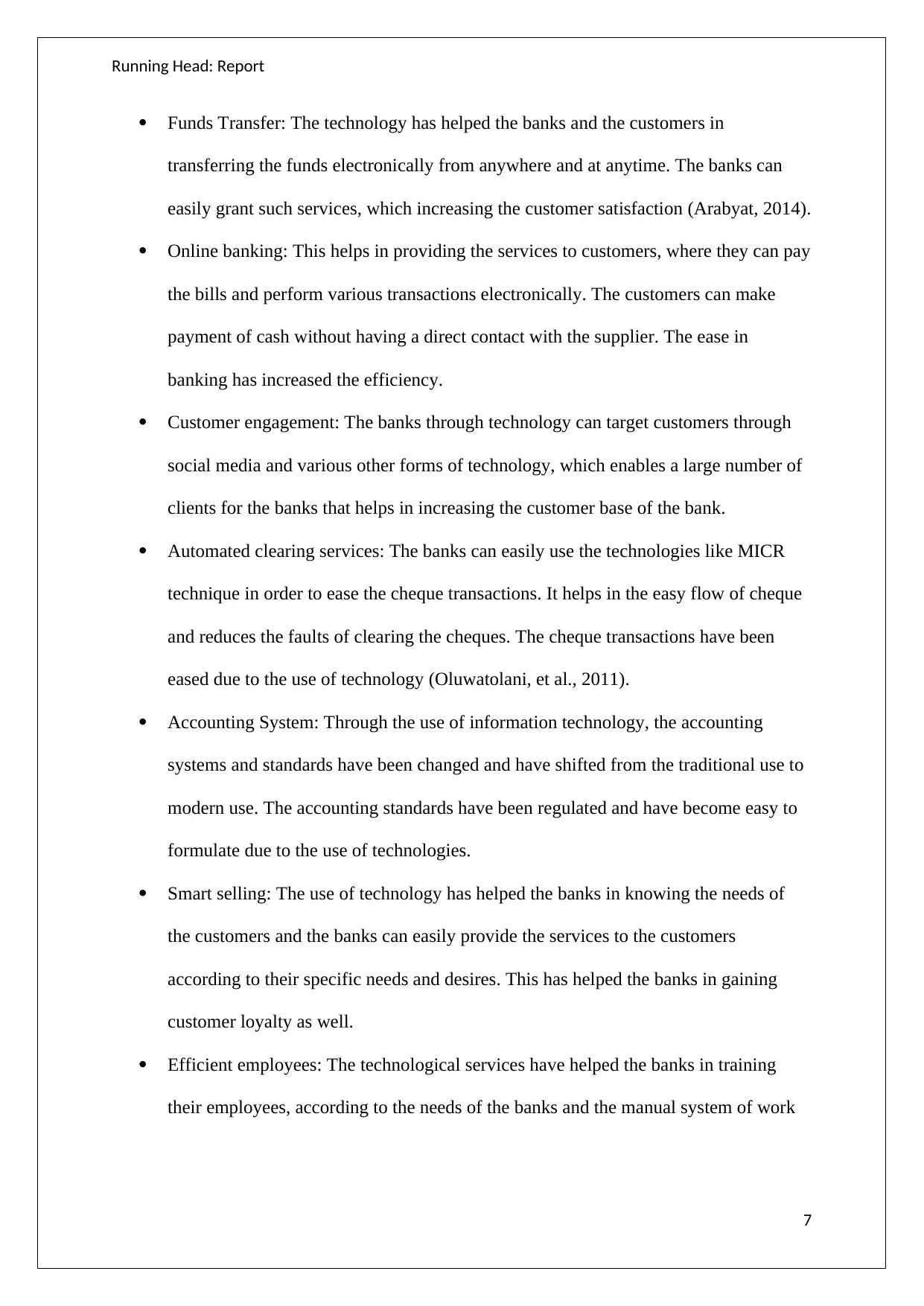
Running Head: Report
Funds Transfer: The technology has helped the banks and the customers in
transferring the funds electronically from anywhere and at anytime. The banks can
easily grant such services, which increasing the customer satisfaction (Arabyat, 2014).
Online banking: This helps in providing the services to customers, where they can pay
the bills and perform various transactions electronically. The customers can make
payment of cash without having a direct contact with the supplier. The ease in
banking has increased the efficiency.
Customer engagement: The banks through technology can target customers through
social media and various other forms of technology, which enables a large number of
clients for the banks that helps in increasing the customer base of the bank.
Automated clearing services: The banks can easily use the technologies like MICR
technique in order to ease the cheque transactions. It helps in the easy flow of cheque
and reduces the faults of clearing the cheques. The cheque transactions have been
eased due to the use of technology (Oluwatolani, et al., 2011).
Accounting System: Through the use of information technology, the accounting
systems and standards have been changed and have shifted from the traditional use to
modern use. The accounting standards have been regulated and have become easy to
formulate due to the use of technologies.
Smart selling: The use of technology has helped the banks in knowing the needs of
the customers and the banks can easily provide the services to the customers
according to their specific needs and desires. This has helped the banks in gaining
customer loyalty as well.
Efficient employees: The technological services have helped the banks in training
their employees, according to the needs of the banks and the manual system of work
7
Funds Transfer: The technology has helped the banks and the customers in
transferring the funds electronically from anywhere and at anytime. The banks can
easily grant such services, which increasing the customer satisfaction (Arabyat, 2014).
Online banking: This helps in providing the services to customers, where they can pay
the bills and perform various transactions electronically. The customers can make
payment of cash without having a direct contact with the supplier. The ease in
banking has increased the efficiency.
Customer engagement: The banks through technology can target customers through
social media and various other forms of technology, which enables a large number of
clients for the banks that helps in increasing the customer base of the bank.
Automated clearing services: The banks can easily use the technologies like MICR
technique in order to ease the cheque transactions. It helps in the easy flow of cheque
and reduces the faults of clearing the cheques. The cheque transactions have been
eased due to the use of technology (Oluwatolani, et al., 2011).
Accounting System: Through the use of information technology, the accounting
systems and standards have been changed and have shifted from the traditional use to
modern use. The accounting standards have been regulated and have become easy to
formulate due to the use of technologies.
Smart selling: The use of technology has helped the banks in knowing the needs of
the customers and the banks can easily provide the services to the customers
according to their specific needs and desires. This has helped the banks in gaining
customer loyalty as well.
Efficient employees: The technological services have helped the banks in training
their employees, according to the needs of the banks and the manual system of work
7
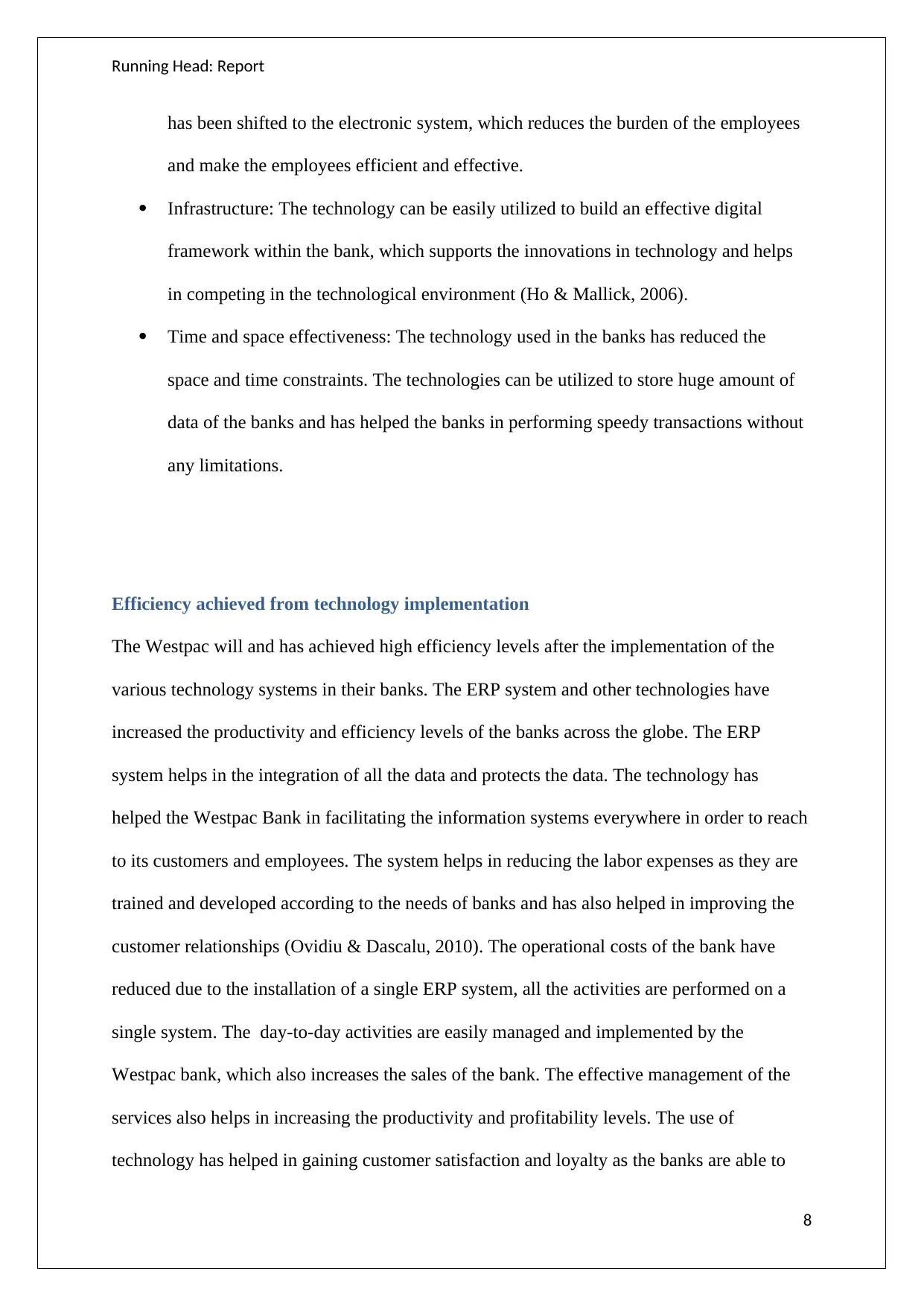
Running Head: Report
has been shifted to the electronic system, which reduces the burden of the employees
and make the employees efficient and effective.
Infrastructure: The technology can be easily utilized to build an effective digital
framework within the bank, which supports the innovations in technology and helps
in competing in the technological environment (Ho & Mallick, 2006).
Time and space effectiveness: The technology used in the banks has reduced the
space and time constraints. The technologies can be utilized to store huge amount of
data of the banks and has helped the banks in performing speedy transactions without
any limitations.
Efficiency achieved from technology implementation
The Westpac will and has achieved high efficiency levels after the implementation of the
various technology systems in their banks. The ERP system and other technologies have
increased the productivity and efficiency levels of the banks across the globe. The ERP
system helps in the integration of all the data and protects the data. The technology has
helped the Westpac Bank in facilitating the information systems everywhere in order to reach
to its customers and employees. The system helps in reducing the labor expenses as they are
trained and developed according to the needs of banks and has also helped in improving the
customer relationships (Ovidiu & Dascalu, 2010). The operational costs of the bank have
reduced due to the installation of a single ERP system, all the activities are performed on a
single system. The day-to-day activities are easily managed and implemented by the
Westpac bank, which also increases the sales of the bank. The effective management of the
services also helps in increasing the productivity and profitability levels. The use of
technology has helped in gaining customer satisfaction and loyalty as the banks are able to
8
has been shifted to the electronic system, which reduces the burden of the employees
and make the employees efficient and effective.
Infrastructure: The technology can be easily utilized to build an effective digital
framework within the bank, which supports the innovations in technology and helps
in competing in the technological environment (Ho & Mallick, 2006).
Time and space effectiveness: The technology used in the banks has reduced the
space and time constraints. The technologies can be utilized to store huge amount of
data of the banks and has helped the banks in performing speedy transactions without
any limitations.
Efficiency achieved from technology implementation
The Westpac will and has achieved high efficiency levels after the implementation of the
various technology systems in their banks. The ERP system and other technologies have
increased the productivity and efficiency levels of the banks across the globe. The ERP
system helps in the integration of all the data and protects the data. The technology has
helped the Westpac Bank in facilitating the information systems everywhere in order to reach
to its customers and employees. The system helps in reducing the labor expenses as they are
trained and developed according to the needs of banks and has also helped in improving the
customer relationships (Ovidiu & Dascalu, 2010). The operational costs of the bank have
reduced due to the installation of a single ERP system, all the activities are performed on a
single system. The day-to-day activities are easily managed and implemented by the
Westpac bank, which also increases the sales of the bank. The effective management of the
services also helps in increasing the productivity and profitability levels. The use of
technology has helped in gaining customer satisfaction and loyalty as the banks are able to
8
⊘ This is a preview!⊘
Do you want full access?
Subscribe today to unlock all pages.

Trusted by 1+ million students worldwide
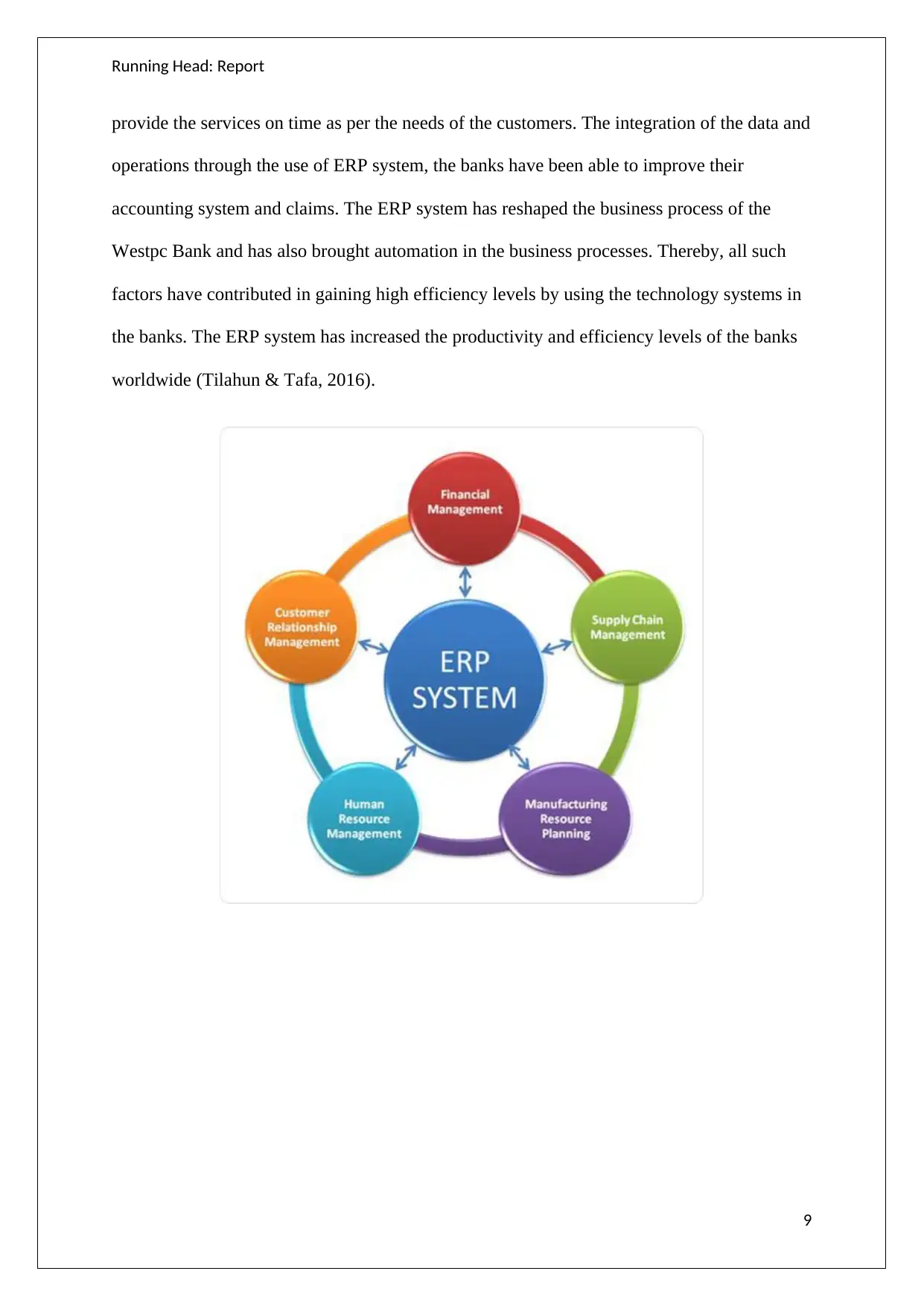
Running Head: Report
provide the services on time as per the needs of the customers. The integration of the data and
operations through the use of ERP system, the banks have been able to improve their
accounting system and claims. The ERP system has reshaped the business process of the
Westpc Bank and has also brought automation in the business processes. Thereby, all such
factors have contributed in gaining high efficiency levels by using the technology systems in
the banks. The ERP system has increased the productivity and efficiency levels of the banks
worldwide (Tilahun & Tafa, 2016).
9
provide the services on time as per the needs of the customers. The integration of the data and
operations through the use of ERP system, the banks have been able to improve their
accounting system and claims. The ERP system has reshaped the business process of the
Westpc Bank and has also brought automation in the business processes. Thereby, all such
factors have contributed in gaining high efficiency levels by using the technology systems in
the banks. The ERP system has increased the productivity and efficiency levels of the banks
worldwide (Tilahun & Tafa, 2016).
9
Paraphrase This Document
Need a fresh take? Get an instant paraphrase of this document with our AI Paraphraser
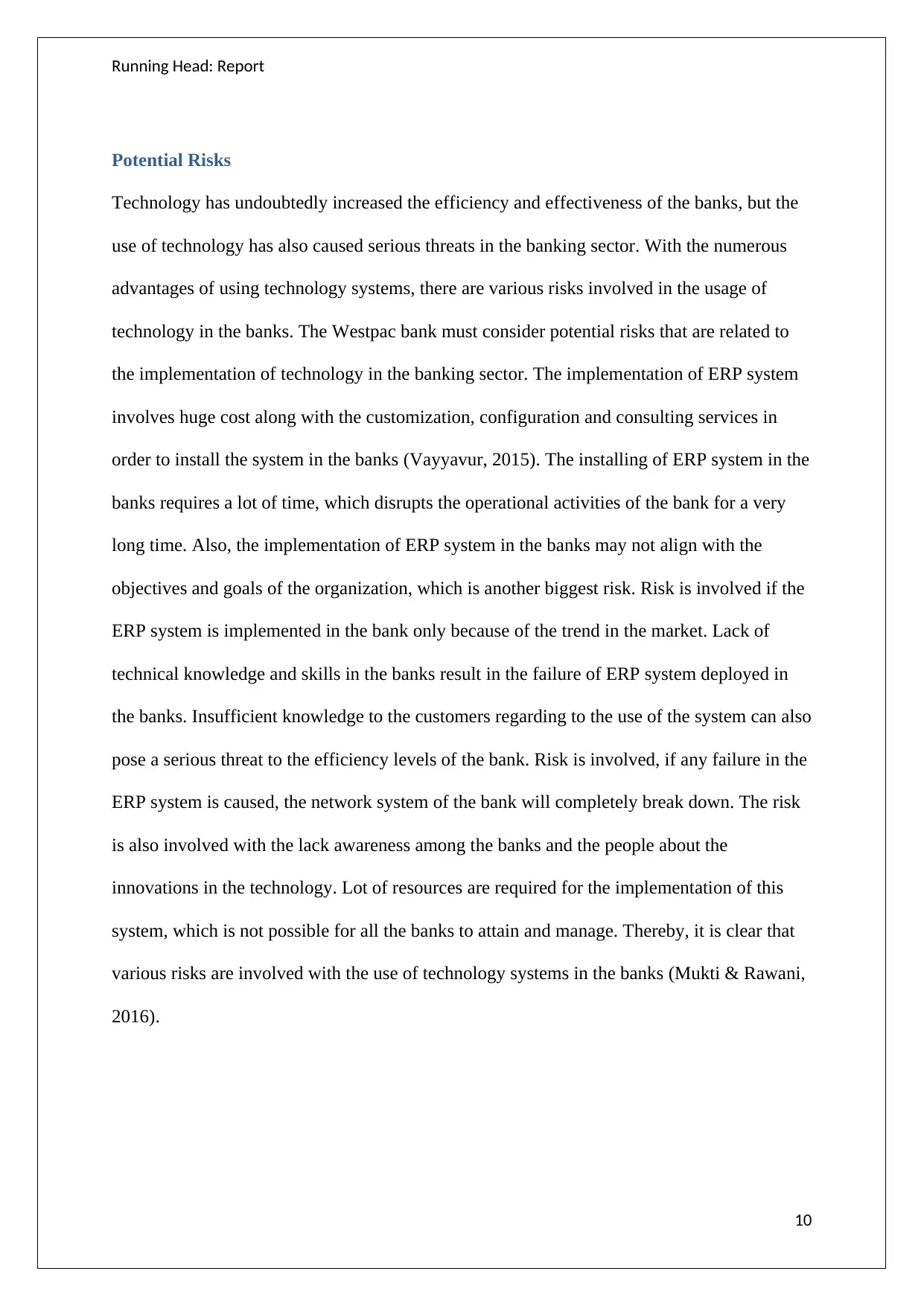
Running Head: Report
Potential Risks
Technology has undoubtedly increased the efficiency and effectiveness of the banks, but the
use of technology has also caused serious threats in the banking sector. With the numerous
advantages of using technology systems, there are various risks involved in the usage of
technology in the banks. The Westpac bank must consider potential risks that are related to
the implementation of technology in the banking sector. The implementation of ERP system
involves huge cost along with the customization, configuration and consulting services in
order to install the system in the banks (Vayyavur, 2015). The installing of ERP system in the
banks requires a lot of time, which disrupts the operational activities of the bank for a very
long time. Also, the implementation of ERP system in the banks may not align with the
objectives and goals of the organization, which is another biggest risk. Risk is involved if the
ERP system is implemented in the bank only because of the trend in the market. Lack of
technical knowledge and skills in the banks result in the failure of ERP system deployed in
the banks. Insufficient knowledge to the customers regarding to the use of the system can also
pose a serious threat to the efficiency levels of the bank. Risk is involved, if any failure in the
ERP system is caused, the network system of the bank will completely break down. The risk
is also involved with the lack awareness among the banks and the people about the
innovations in the technology. Lot of resources are required for the implementation of this
system, which is not possible for all the banks to attain and manage. Thereby, it is clear that
various risks are involved with the use of technology systems in the banks (Mukti & Rawani,
2016).
10
Potential Risks
Technology has undoubtedly increased the efficiency and effectiveness of the banks, but the
use of technology has also caused serious threats in the banking sector. With the numerous
advantages of using technology systems, there are various risks involved in the usage of
technology in the banks. The Westpac bank must consider potential risks that are related to
the implementation of technology in the banking sector. The implementation of ERP system
involves huge cost along with the customization, configuration and consulting services in
order to install the system in the banks (Vayyavur, 2015). The installing of ERP system in the
banks requires a lot of time, which disrupts the operational activities of the bank for a very
long time. Also, the implementation of ERP system in the banks may not align with the
objectives and goals of the organization, which is another biggest risk. Risk is involved if the
ERP system is implemented in the bank only because of the trend in the market. Lack of
technical knowledge and skills in the banks result in the failure of ERP system deployed in
the banks. Insufficient knowledge to the customers regarding to the use of the system can also
pose a serious threat to the efficiency levels of the bank. Risk is involved, if any failure in the
ERP system is caused, the network system of the bank will completely break down. The risk
is also involved with the lack awareness among the banks and the people about the
innovations in the technology. Lot of resources are required for the implementation of this
system, which is not possible for all the banks to attain and manage. Thereby, it is clear that
various risks are involved with the use of technology systems in the banks (Mukti & Rawani,
2016).
10
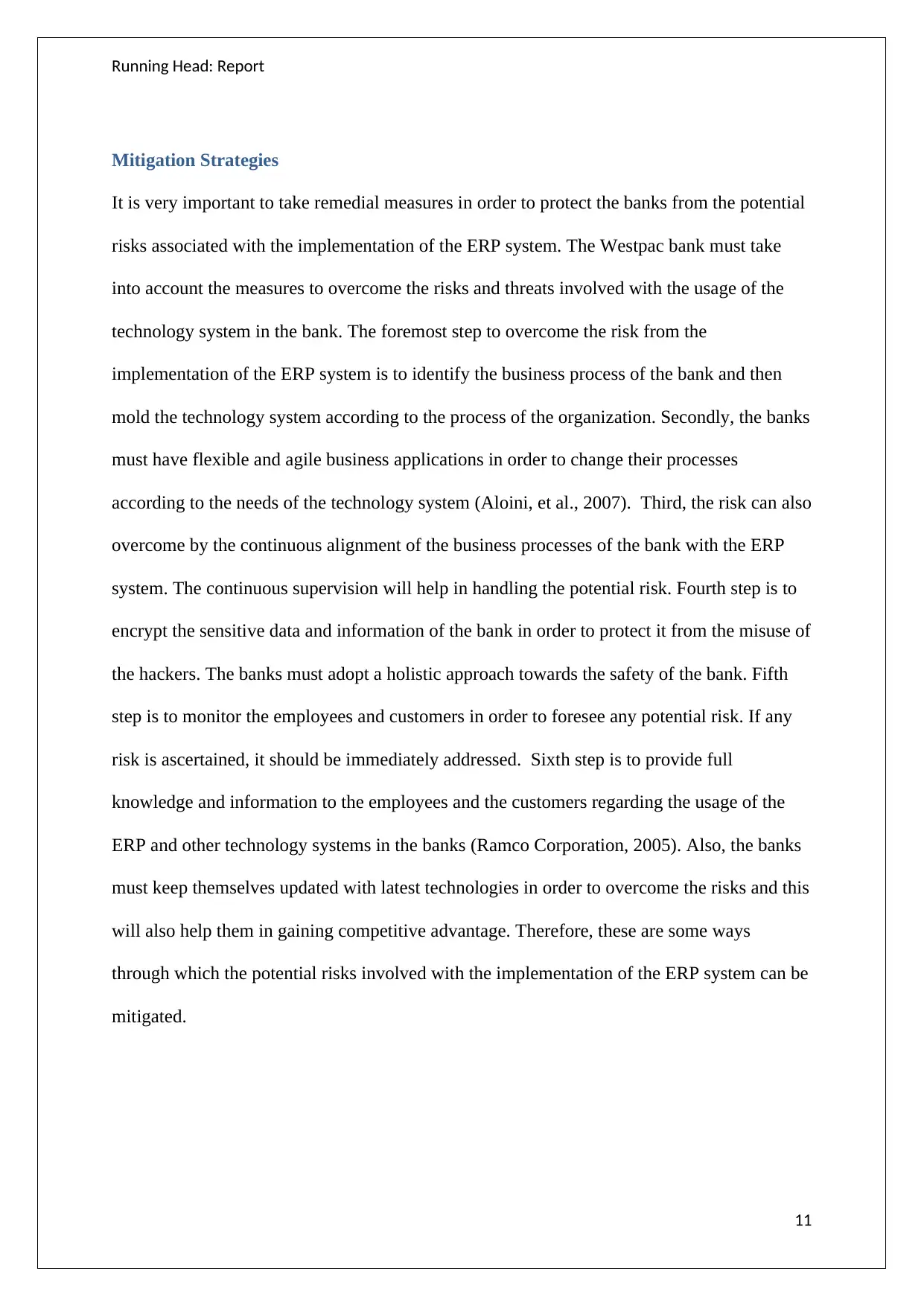
Running Head: Report
Mitigation Strategies
It is very important to take remedial measures in order to protect the banks from the potential
risks associated with the implementation of the ERP system. The Westpac bank must take
into account the measures to overcome the risks and threats involved with the usage of the
technology system in the bank. The foremost step to overcome the risk from the
implementation of the ERP system is to identify the business process of the bank and then
mold the technology system according to the process of the organization. Secondly, the banks
must have flexible and agile business applications in order to change their processes
according to the needs of the technology system (Aloini, et al., 2007). Third, the risk can also
overcome by the continuous alignment of the business processes of the bank with the ERP
system. The continuous supervision will help in handling the potential risk. Fourth step is to
encrypt the sensitive data and information of the bank in order to protect it from the misuse of
the hackers. The banks must adopt a holistic approach towards the safety of the bank. Fifth
step is to monitor the employees and customers in order to foresee any potential risk. If any
risk is ascertained, it should be immediately addressed. Sixth step is to provide full
knowledge and information to the employees and the customers regarding the usage of the
ERP and other technology systems in the banks (Ramco Corporation, 2005). Also, the banks
must keep themselves updated with latest technologies in order to overcome the risks and this
will also help them in gaining competitive advantage. Therefore, these are some ways
through which the potential risks involved with the implementation of the ERP system can be
mitigated.
11
Mitigation Strategies
It is very important to take remedial measures in order to protect the banks from the potential
risks associated with the implementation of the ERP system. The Westpac bank must take
into account the measures to overcome the risks and threats involved with the usage of the
technology system in the bank. The foremost step to overcome the risk from the
implementation of the ERP system is to identify the business process of the bank and then
mold the technology system according to the process of the organization. Secondly, the banks
must have flexible and agile business applications in order to change their processes
according to the needs of the technology system (Aloini, et al., 2007). Third, the risk can also
overcome by the continuous alignment of the business processes of the bank with the ERP
system. The continuous supervision will help in handling the potential risk. Fourth step is to
encrypt the sensitive data and information of the bank in order to protect it from the misuse of
the hackers. The banks must adopt a holistic approach towards the safety of the bank. Fifth
step is to monitor the employees and customers in order to foresee any potential risk. If any
risk is ascertained, it should be immediately addressed. Sixth step is to provide full
knowledge and information to the employees and the customers regarding the usage of the
ERP and other technology systems in the banks (Ramco Corporation, 2005). Also, the banks
must keep themselves updated with latest technologies in order to overcome the risks and this
will also help them in gaining competitive advantage. Therefore, these are some ways
through which the potential risks involved with the implementation of the ERP system can be
mitigated.
11
⊘ This is a preview!⊘
Do you want full access?
Subscribe today to unlock all pages.

Trusted by 1+ million students worldwide
1 out of 16
Related Documents
Your All-in-One AI-Powered Toolkit for Academic Success.
+13062052269
info@desklib.com
Available 24*7 on WhatsApp / Email
![[object Object]](/_next/static/media/star-bottom.7253800d.svg)
Unlock your academic potential
Copyright © 2020–2025 A2Z Services. All Rights Reserved. Developed and managed by ZUCOL.





